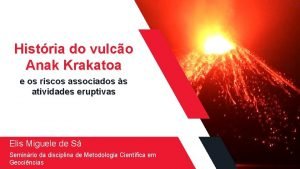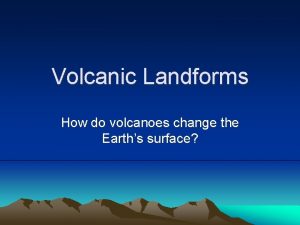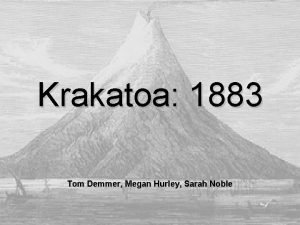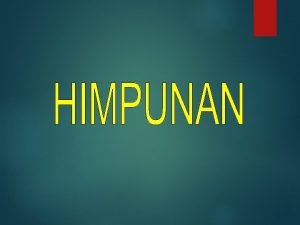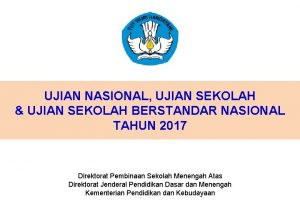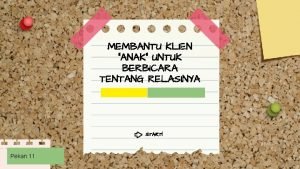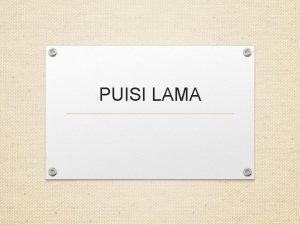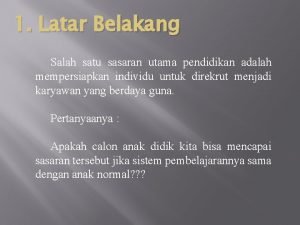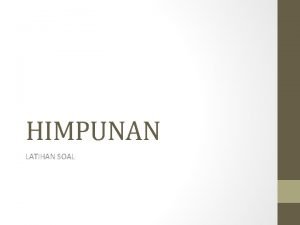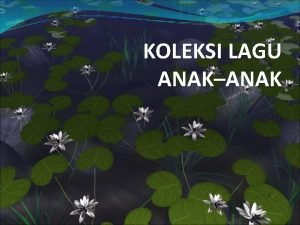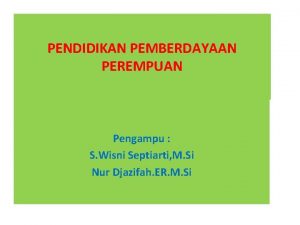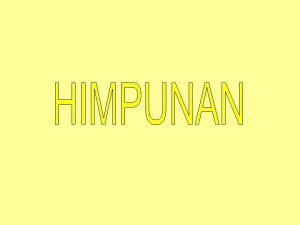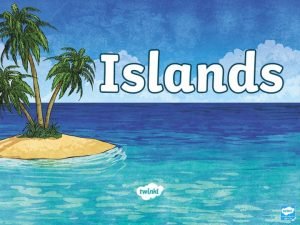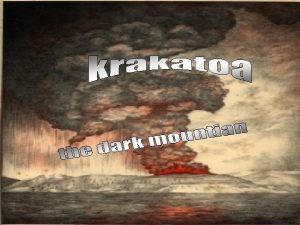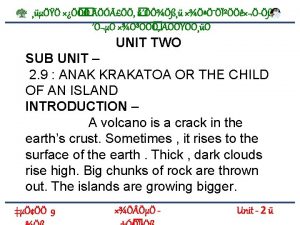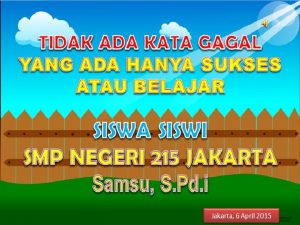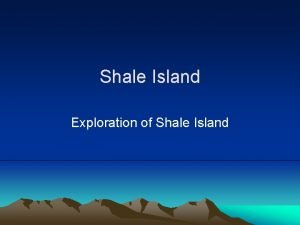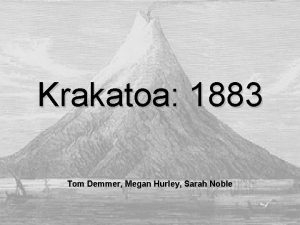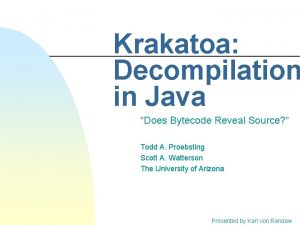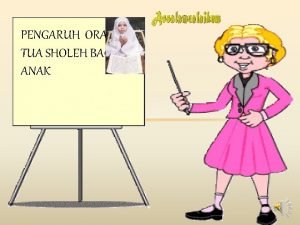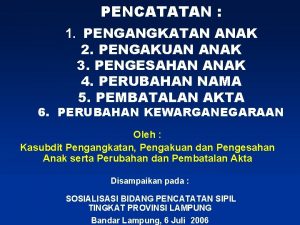Anak Krakatoa or the Child of an Island




















- Slides: 20

Anak Krakatoa or the Child of an Island

Anak Krakatau, Indonesia (#1)

Krakatoa is an island in the Sunda Strait between Java and Sumatra in Indonesia. It is known for its volcano which erupts regularly. What is a volcano? A volcano is a crack or opening in the earth's crust. There is hot molten rock near the earth's centre. Sometimes, it rises to the surface of the earth through such a crack or opening and flows out. When this happens, we say that the volcano has erupted.

Krakatoa is an island in the Sunda Strait between Java and Sumatra in Indonesia.

A volcano eruption happens on a tremendous scale. Thick dark clouds of smoke rise high from the opening and spread in the sky. Big, glowing, burning chunks of rock and red hot lava are thrown out of the crack in the earth. Very hot mud and ash are also thrown out. A great volcanic eruption can change the land forms in an area.

Thick dark clouds of smoke rise high from volcano

Classification of Volcanoes are popularly classified into three categories :

(A) ACTIVE VOLCANOES: erupt regularly

(B) DORMANT VOLCANOES: now quite, find information about their eruptions in history

(C) EXTINCT VOLCANOES: used to erupt long, long ago, but there is no record of it in history

Krakatoa is an active volcano. It has erupted many times causing great disaster. The worst of the eruptions took place in August 1883. The volcano erupted with such a loud boom that it was heard more than 3500 km away in Australia. It is believed to be the sound that man has ever heard. The island, which was a volcanic mountain, collapsed on itself. The dust that was thrown up in the eruption rose to about 80 km in the sky. It spread in the sky around the world and later settled in different parts of the world thousands of kilometres away.

The worst of the eruptions took place in August 1883.

The eruption caused giant waves or tsunamis in the sea near the island. About 165 villages and towns were destroyed due to the eruption and the tsunamis. The eruption destroyed two thirds of the island of Krakatoa. It collapsed beneath the surface of the sea, creating a huge underwater volcanic crater or hole. The hole was more than 6 km wide. Then in 1927, a plume of smoke rose out of the water on the crater. It was followed by another eruption. A few days later, a new island volcano broke water. How did it happen?

In 1927 another eruption broke water

When the underwater volcano threw up ash and rock, it was quickly taken away by the sea water. But then the lava started flowing out of the crater faster. This volcanic material was not all taken away by the waves, and a new mountain begain to grow. It kept growing and was soon seen above the water. Thus a new island grew from the old island of Krakatoa. It was named ‘Anak Krakatoa’ or the ‘Child of Krakatoa’. Anak Krakatoa is still an active volcano. Eruptions have begun again since 1994. It lies quite for a few days and then again there are eruptions. With more lava flowing out, the island is still growing bigger. Since 1950, the island has grown at an average rate of five inches per week!

A part of the old island known as Rakata is still visible in the sea, a little away from the arrival- Anak Krakatoa's eruption in 1883, all the surrounding islands and coast were covered with hot ash. No life remained. When a scientist visited it in 1884, he found just one spider there. But the living on Rakata was not lost and gone forever. The wind and the sea brought seed of plants to the island. Some seeds came with the birds who flew over the island. Plants and animals that live in the sea came to the coasts again. Small land animals like ants, termites or even rats and lizards travelled to the island was soon teeming with plants and animals.

The living on Rakata was not lost and gone forever

It was like a laboratory where scientists can see how living things slowly develop in an area. Today, scientists can observe this also in a part of Anak Krakatoa, which does not get covered with volcanic ash.

The western coast of Java was greatly affected by Krakatoa's eruption. Very few human beings were left there. But the wild animals and plants in that area grew in number again. In fact, wildlife grew naturally since there were no human beings to interfere with it- there was no one there to cut the trees or kill the animals. So, this region has now become rich in wildlife.

The western coast of Java was greatly affected by Krakatoa's eruption
 Krakatoa latitude and longitude
Krakatoa latitude and longitude How do volcanoes change landforms?
How do volcanoes change landforms? Marianne demmer
Marianne demmer Dari 60 orang siswa ternyata 36 orang gemar membaca
Dari 60 orang siswa ternyata 36 orang gemar membaca Contoh soal radd
Contoh soal radd Diagram venn di bawah ini menunjukkan banyak siswa
Diagram venn di bawah ini menunjukkan banyak siswa Assabiquunal awwaluun dari golongan anak-anak adalah
Assabiquunal awwaluun dari golongan anak-anak adalah Doa buat anak ujian sekolah
Doa buat anak ujian sekolah Pembagian warisan 2 anak laki dan 2 anak perempuan
Pembagian warisan 2 anak laki dan 2 anak perempuan Dari 60 orang siswa ternyata 36 orang gemar membaca
Dari 60 orang siswa ternyata 36 orang gemar membaca Konseling relasi anak anak
Konseling relasi anak anak Seloka
Seloka Mengapa anak-anak menjadi sasaran utama pendidikan
Mengapa anak-anak menjadi sasaran utama pendidikan Tabular form adalah
Tabular form adalah Lagu anak sayang semuanya ciptaan
Lagu anak sayang semuanya ciptaan Peranan anak lelaki dan anak perempuan
Peranan anak lelaki dan anak perempuan Perhatikan gambar disamping yang bukan anggota k adalah
Perhatikan gambar disamping yang bukan anggota k adalah Cabaran ibu bapa dalam mendidik anak anak pdf
Cabaran ibu bapa dalam mendidik anak anak pdf Dari 60 orang siswa ternyata 36 orang gemar membaca
Dari 60 orang siswa ternyata 36 orang gemar membaca What is an island?
What is an island? Ellis island vs. angel island
Ellis island vs. angel island
